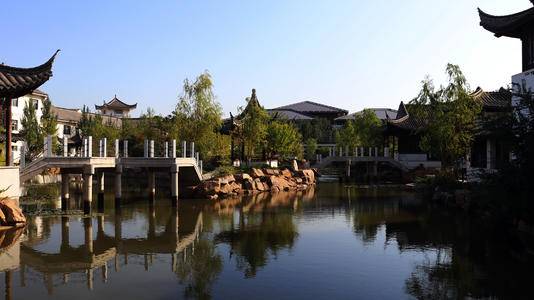Panjin Jiangnan Style Garden
The park integrates ancient architectural arts such as mortise and tenon craftsmanship, painting, Huizhou carving, plaque making, couplets, stone strips, and carving, complemented by garden flowers and trees, with profound meanings and emotional expressions through rock arrangements. It features architectural styles and levels from the Song, Yuan, Ming, and Qing dynasties. The garden's craftsmanship in changing scenes and landscapes reflects the deep cultural heritage of Jiangnan. Its construction craftsmanship can be regarded as the pinnacle of ancient architecture. It is the largest private garden in China in nearly three hundred years, second only to the Old Summer Palace, filling the historical gap of no gardens in the Northeast region for two thousand years.
Tomb of Martyrs of the Last Battle of the First Sino-Japanese War
The Tomb of Martyrs of the First Sino-Japanese War is located in Tianzhuangtai Town, Dawa County, Panjin City. It is a memorial site built by the Qing army to honor the martyrs who died in the First Sino-Japanese War and is an important part of the First Sino-Japanese War site group. Although the Qing dynasty failed in the First Sino-Japanese War due to its decline, the last battle of the war, the Battle of Tianzhuangtai, saw countless patriotic Qing soldiers shed their blood. The Battle of Tianzhuangtai was the largest engagement since the start of the war, with the most Japanese troops involved and the last large-scale battle between the two sides. In March 1895, facing tens of thousands of Japanese invaders, patriotic General Ma Yukun led his troops in a fierce resistance on the west bank of the Liao River, where over two thousand soldiers sacrificed their lives for the country. Today, the remains of the Qing soldiers who died for their country rest in the Tomb of Martyrs of the First Sino-Japanese War.
Shangkouzi Folk Village is rich in ecological resources, featuring natural reed marshes and over 200 species of birds. It is locally known for the 'Three Treasures of the Liao River' (cockles, wild reed shoots, and river knife fish), with the wild reed shoots being featured in 'A Bite of China 2'. The village has a long history of folk culture, with the unique Shangkouzi stilt dance, which has been passed down for over 300 years and is a protected intangible cultural heritage project. In 2012, it won the 'Shanhua Award'. In 2013, it was invited to perform at the opening ceremony of the '12th National Games'. Additionally, there are exhibitions of reed weaving and paper-cutting art. The Liao River Green Water Bay Scenic Area offers various tourist activities such as rafting on the Liao River, beach swimming, cage fish farming, ecological picking, and a CS base. Attractions include the Manchu-Han Courtyard, Water House, and Agricultural Garden. The total area of the tourist zone is 10.2 square kilometers, and its unique Liao River wetland scenery and rich folk culture attract visitors from all over.
Hanzhang Lake Tourism Resort
Hanzhang Lake Tourism Resort is located at the entrance of the Liao River at the southern end of the famous 'Wetland Capital' Panjin Liaodong Bay New Area, west of the Panjin Olympic Sports Center. It covers a total area of 470,000 square meters, with a total building area of about 22,000 square meters and a total area of 10 square kilometers, housing more than 200 large, medium, and small vessels. The resort includes over 10 tourist projects such as the Hanzhang Lake International Yacht Club, International Sailing Club, International Kayak Club, International RV Camp, Dynamic Waterfront Cruise Terminal, Ger Tribe Camp, Zero Point Container Commercial Street, Waterfront Shuishang Street, Global Village Cottage Villas, Yulu Flower Sea, Qihang Square Water Music Fountain, and more.
Panjin Rice Museum
Address: 50 meters from the Panjin North Exit of the Jing-Shen Expressway, Panshan County, Panjin City. The rice exhibition is located in the Panjin Specialty Products Park in Panshan County, Panjin City, mainly showcasing world rice, Chinese rice, Panjin rice varieties, and agricultural culture. According to the introduction, the project covers an area of 12,400 square meters, with a building area of 12,000 square meters, and also includes the River Crab Museum, the Reed Shoot Museum, and the Reed Art and Grass Weaving Hall.













